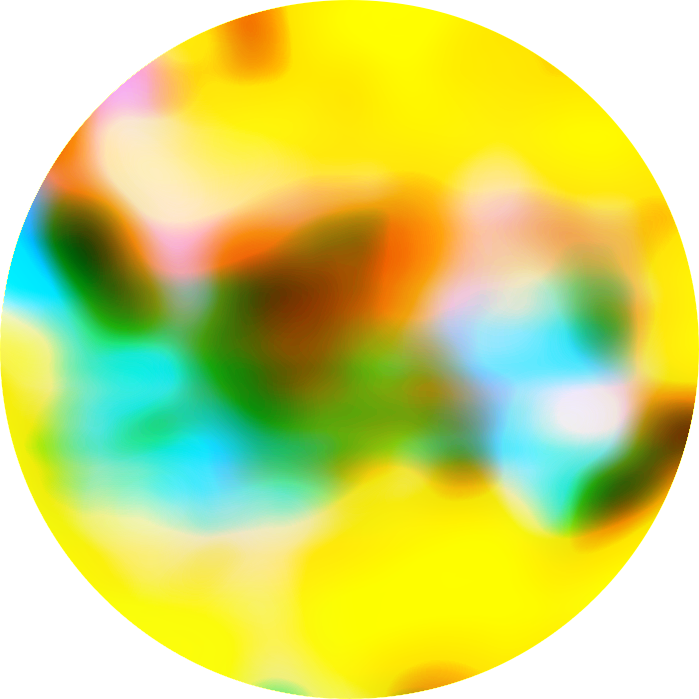Specter of Reality:
Bro(c)ken Perception
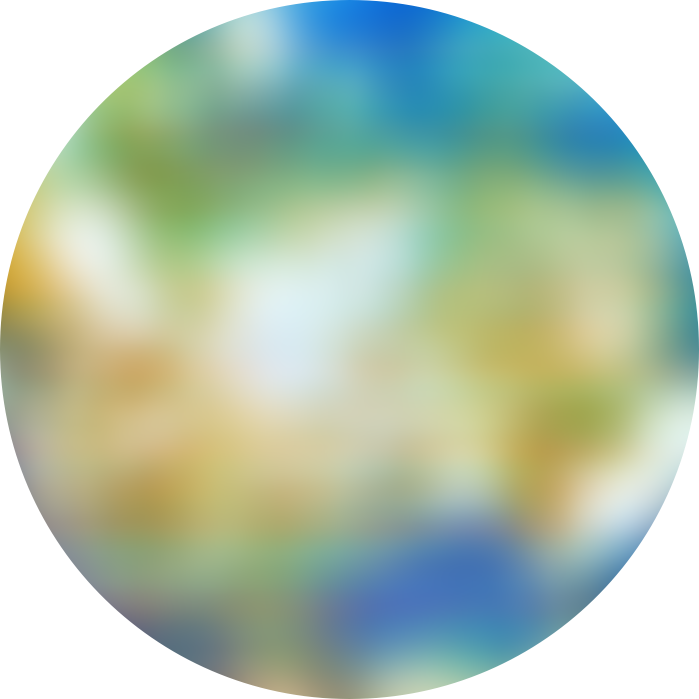
Abstract
In my thesis titled Specter of Reality: Bro(c)ken Perception I would like to investigate the Brocken Specter which is a natural phenomenon formed by light diffraction and the observer’s shadow being cast upon the mist. The Brocken Specter borrows its name from the Brocken Summit in the Harz mountains in Germany. A rare occurrence that happened there has led to different approaches to elucidate, both scientifically and culturally. I wish to focus on this specific phenomenon’s implications throughout history and the wide variety of its interpretations as a case study leading to the wider topic of the way we perceive, form and narrate reality. I’m interested in the stories about this formation, which are a result of the urge to explain an experience not completely understood in ancient times.
Eliminating the distress of the unknown, incomprehensible and achieving cognitive closure
1
Arie Krugalinski who is a social psychologist is the first one to use this term. He defines it as “individuals' desire for a firm answer to a question and an aversion toward ambiguity,” search for certainty in uncertainty.
has always been a purpose of the humankind. There is a constant curiosity for the dimensions beyond our senses, which only provide us with a limited view on reality. In cases such as the Brocken Specter, we experience a glimpse of the universe’s creative force and as Tavi Meraud mentions in their writing “... it seems necessary to bracket everything that is foreign to consciousness whilst … another reality has been momentarily illuminated .”
2Meraud, Tavi."Iridescence, Intimacies". E-flux, January 2015.www.eflux.
com/journal/61/
60995/iridescence-
intimacies/
We are exposed to the result of something bigger, Bildungstrieb
3Nisus formativus. In English ‘formative impulse’. The theory of Bildungstreib was introduced by the physician Johann Blumenbach and described as the effective drive in organisms which activates itself through time, the logic behind nature’s own formations and compositions.,
a force forming an occurrence visible to the eye like this particular light phenomenon, hence we lack the precise delineation of why this exists in the way it makes us dependent on theories developed. I find it mesmerizing to not only investigate the mystery behind the natural formations of reality with (optical) technologies at our disposal, but that one can become a creator and narrator of new dimensions, too.
In this paper, I would like to take you on a little journey of thoughts and debate on illusions of dimensions from light and sky phenomena to humanmade digital worlds through chapters, perception and interpretations of reality by presenting some divergent narratives. The main protagonist remains the phenomenon of the Brocken Specter via which I touch upon the topics mentioned above.Ultimately, the Brocken Specter becomes the lens through which I read those related themes.
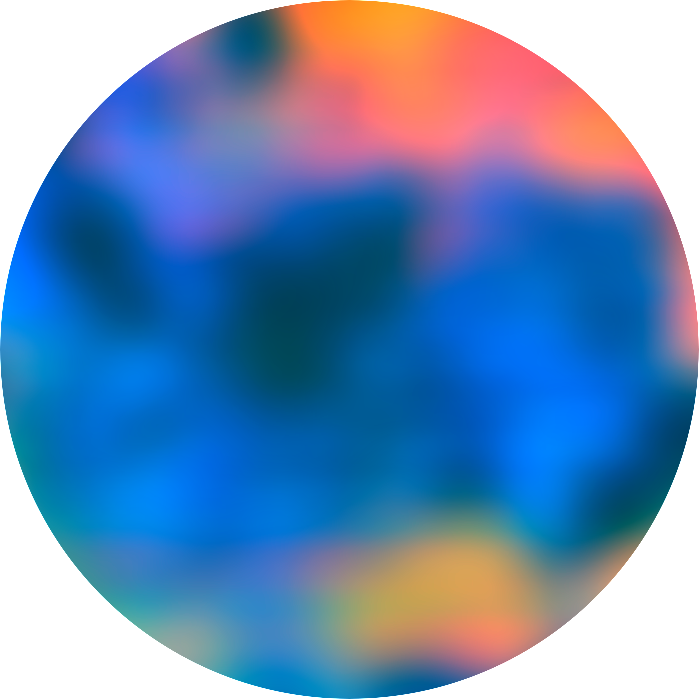
The Luminous Mist
My field of perception is constantly filled with a play of colours, noises and fleeting tactile sensations which I cannot relate precisely to the context of my clearly perceived world, yet which I nevertheless immediately ‘place’ in the world, without ever confusing them with my daydreams. (Ponty, IX)
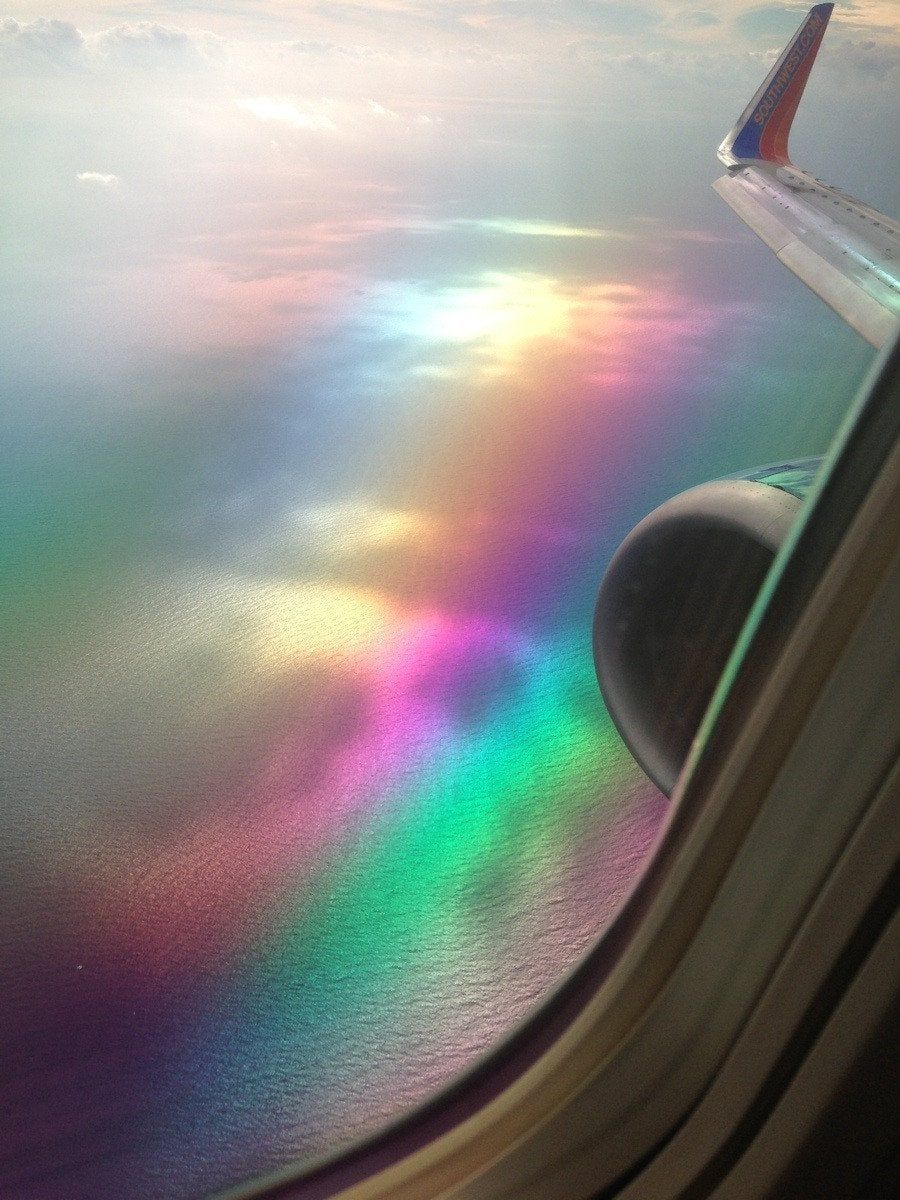 1. Image from a birefringent airplane window.
1. Image from a birefringent airplane window.
Staring at the clouds for over three hours that I spent in the air, on my flight back from Istanbul to Amsterdam I was determined to spot the Brocken Specter known also as the pilot’s glory. Despite being unlucky to be a spectator to this phenomenon, even the view of merely the clouds gave a heavenly impression of a soft, cushion like touchable surface, that is composed of water droplets or ice crystals floating in the sky – those do not have a specific condition, soft or hard. The second thing I caught a sight of was an illusion of a rainbow-like coloring of the sky caused by the birefringent 4 Birefringence is formally defined as the double refraction of light in a transparent, molecularly ordered material, which is manifested by the existence of orientation-dependent differences in refractive index.(Murphy, Douglas B. et al.) quality of the anisotropic 5Quality of having different values measured from different directions. aircraft window. Both these instances, the mist and the diffraction of light, are vital for the formation of the Brocken Specter. Though I had a glimpse at only two qualities and not the occurrence itself, the components of this image made me wonder about our perception and the limited capacity of our human senses. I realized that what attracts my attention is the inextricability of reality.
Detlev Möller, a professor of atmospheric chemistry states that “The phenomena – fog, mist and clouds, precipitation (rain, snow, hail) and dew – have been described since Antiquity. A phenomenological understanding of the physical (but not chemical) processes associated with hydrometeors was complete only by the end of the 19th century.” (11) Before there was a scientific truth to hold on to, you can imagine that the previous generations would have their own explanatory methods for the emergencies in the celestial blues, which were beyond their capacity of solving. In ancient times, humankind would portray the extraordinary sky phenomena through stories, cultural and religious expounding.
Personally, I have come across the topic of the Specter of Brocken while researching several photo meteors. These “which consist of a number of atmospheric phenomena attributed to the reflection or refraction of visible light in the sky by liquid water droplets, ice crystals, by the air itself, or by solid particles in the air, such as volcanic ash or dust.” 6 U.S. Navy. “Aerographer’s Mate: Module 1 - Surface Weather Observations”. N.p: CreateSpace Independent Publishing Platform, 3 January 2011. Print. (37) I find it an interesting topic to touch upon as it has a variety of interpretations and its relevance to the discourse of reality perception.
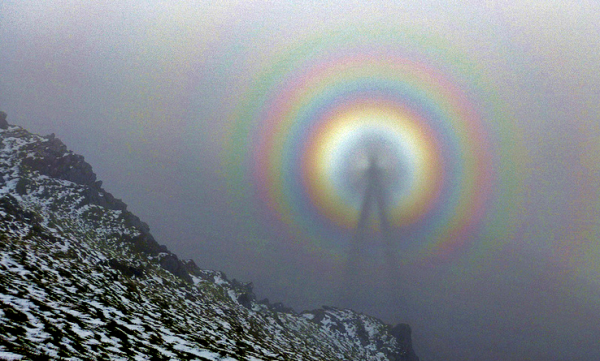 2.The Brocken Specter.
2.The Brocken Specter.
The scientific description of the specter reads as follows; ‘the sun causes a shadow to fall upon (and through) the water droplets of the cloud or fog. The distance of the shadow makes it hard for the viewer to accurately judge the size and proportions of the shadow. The colorful solar glory often seen around the shadow is produced by light refracting within the water droplets. As clouds shift, the Brocken Spectre can seem to flicker and move’. 7Muzdakis, Madeleine. "‘Brocken Spectre’ Is A Rare Yet Beautiful Optical Phenomenon Of A Radial Rainbow". My Modern Met, 2021. In my opinion a scientific approach is a method of storytelling to clarify the blurriness. Another approach comes from a more emotional perspective and mesmerism, such as the instance written by Coleridge from the romantic literature genre:
This light, this glory, this fair luminous mist,
This beautiful and beauty-making pow’r
Joy, virtuous Edmund! Joy that ne’er was given
Save to the pure and in their purest hour,
Joy, Edmund, is the spirit and the pow’r
Which, wedding nature to us, gives in dow’r
A new earth and new heaven.
(Coleridge, lines 63-69)
8
Part from the poem 'Dejection: An Ode'.
The radiance, coloring and size comes as a disturbing image which does not give an explanatory satisfaction, unrevealing the magic peculiarity of the universe. Comparing those two approaches, both are a description of an experience and a comment based on the viewer’s perception. Perception comes from the Latin word percepio having the meaning of receiving, gathering and understanding with our mind and senses. The world as we apprehend it objectively or describe with storytelling/ science, is only in the limit of what we can grasp. I think the objectivity of the world perceived comes from a consensus within a quantity of spectators with the same outcome from an experience. According to Husserl, ‘the real world is pre-given to us,’ and we discover it by ‘onward movement of experience’ .
Nowadays, not only are we the central source of our comprehension of the surrounding, but with the evolving technologies we try to simulate it becoming the Gods of new windows, into which we implement a translation of reality, deriving inspiration from natural occurrences. How do we interpret reality with the limitations of senses and poor perception based on our experiences (phenomenology) of our circumambient while striving to conquer and create a new dimension? How do we explain at first sight what we don’t understand? Do we view merely a specter of reality? It makes me think if our experiences just projections of phenomena and with cutting-edge mediums do we construct a shadow of a shadow?
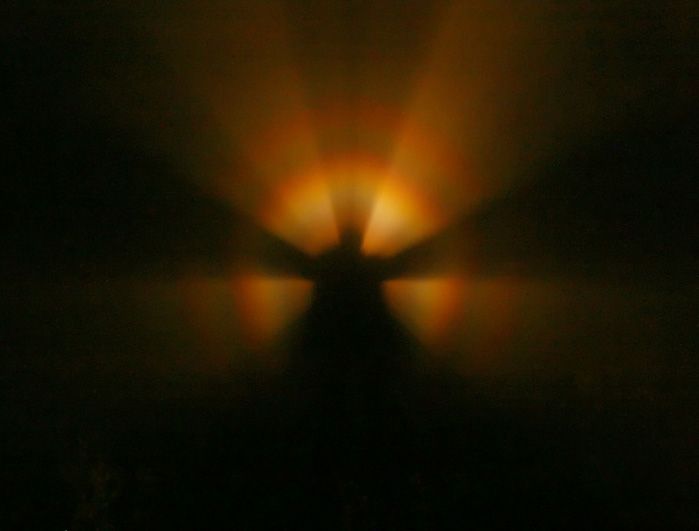 3.The Brocken Specter captured at night.
3.The Brocken Specter captured at night.
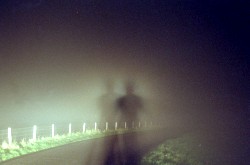 4. A specter created by artificial car light and a person's shadow.
4. A specter created by artificial car light and a person's shadow.
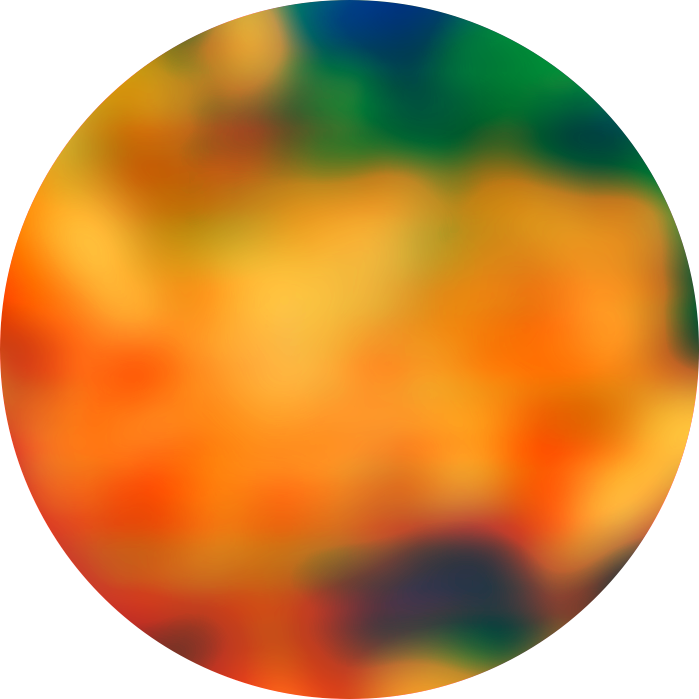
Above The Cloud
“What we observe is not nature itself, but nature exposed to our method of questioning.”(Heisenberg, 42)9 Heisenberg, Werner. “Physics and Philosophy: The Revolution in Modern Science”. Harper Perennial Modern Classics,1928,8 May 2007. Print.
First, Sight!The gray blurry layer of fog was covering the surface of the mountain, as it did 330 days on average per year. The mountain with an elevation of 1,142 meters, had its’ own unique heartless atmosphere with its harsh weather conditions, exceptionally low temperatures and extreme winds howling on the isolated summit. Due to its unwelcoming circumstances, few tree species were willing to root at higher altitudes and it resembled the conditions in the Alps at 2,000 meters. The trees were suppressed by this rude host who hinders their growth, staying small, it is hard to estimate their actual age.
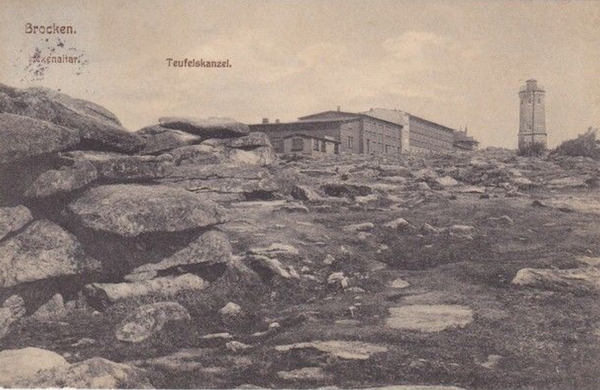 5. Teufelskanzel on the Brocken Summit.
5. Teufelskanzel on the Brocken Summit.
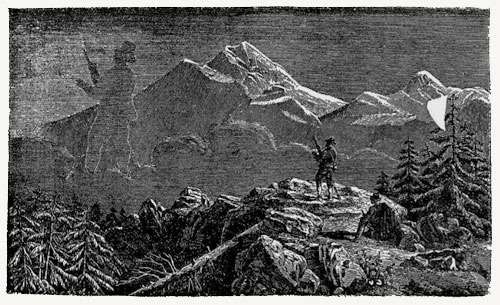 6. Great Disasters and Horrors in the World's History, c.1890.
6. Great Disasters and Horrors in the World's History, c.1890.Depiction of The Specter of Brocken.
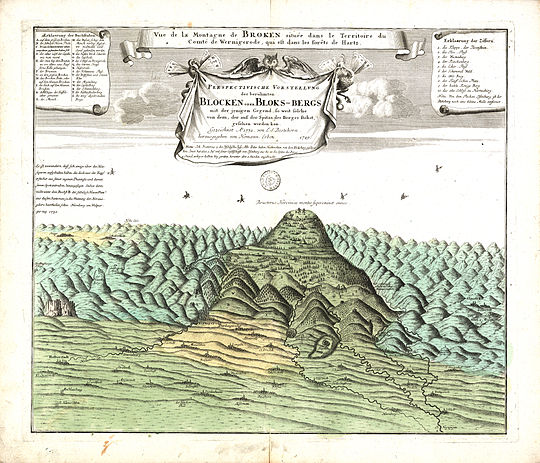 7. Darstellung des Brockens von L. S. Bestehorn aus dem Jahr 1732.
7. Darstellung des Brockens von L. S. Bestehorn aus dem Jahr 1732.Map of The Brocken Mountain.
It was most probably somewhere between the Hexenaltar (in English Witches' Altar) and Teufelskanzel (in English Devil's Pulpit) where Johann was hiking in the nebulous ambience when he spotted the phenomenon which he named after the location. Born in 1721, Johann Esaias Silberschlag, a Lutheran theologian and natural scientist, was 59-year-old at the time. Johann depicted:
If the observer's shadow falls on a layer of fog or cloud, the shadow is not depicted by a solid surface, but by each drop of water in the haze individually. As a result, the brain cannot see the shadow stereoscopically and clearly overestimates the size. Air movements move the shadow, even when the observer is standing still. This apparently own being can also float without having any visible contact with the ground.
10
“Achtermannshöhe (HWN 12).” Komot, 2021, www.komoot.com/
highlight/106735.
I believe the fact we are prone to stereoscopic vision, just like in Silberschlag’s description, which is the first documentation of the specter, might lead to a confusion in the case of the brain not making a distinction. We are predisposed to see stereoscopically due to the placement of our eyes.
11
Nvcadmin. “Stereoscopic Vision – How Does It Work? – NovaVision.” Novavison.Com, novavision.com/
stereoscopic-vision-how-does-it-work. Accessed 31 Mar. 2022.
Having two eyeballs placed on the same level results in our brain creating an image from two images and their subtle differentiation in the retina. That’s how the brain constructs one joint image with a feeling of depth and third dimension. As the phenomenon is an illusion, it leads to a conciliation in between (un)real dimensions. I think of the Brocken Specter as a metaphor of our ‘broken’ perception and a lack of orientation of the reality. “The uncanny and disorienting effect of the Brocken Specter became emblematic of the unreliability of the sensory apparatus.” (Verderame, 147) The inadequate number of signals detected by human senses pushes us to flatten the image and add a new meaning of layer to it, because of our blind spot
12
Physiologically the blind spot in the eye is the part which doesn’t have photoreceptors so it can’t provide visual information. But also has the meaning of lack of knowledge or ignored information as a phrase.
.
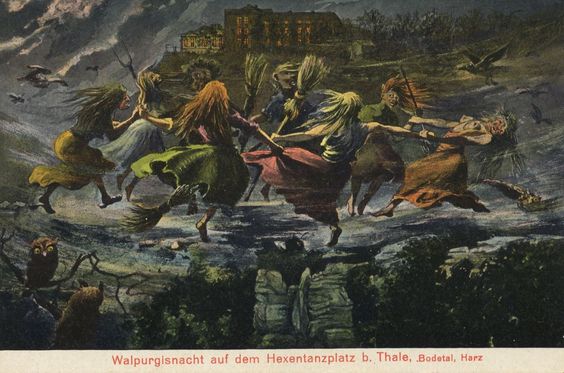 8. Witch ritual at the Harz Mountains.
8. Witch ritual at the Harz Mountains.
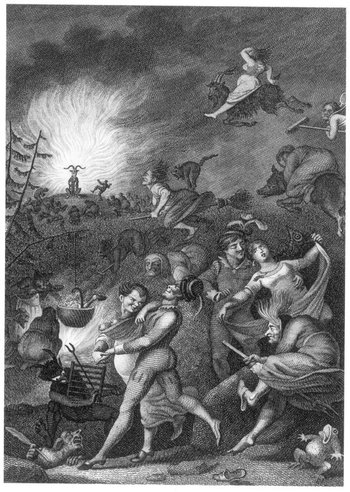 9. Portrayal of the Walpurgis Night.
9. Portrayal of the Walpurgis Night.
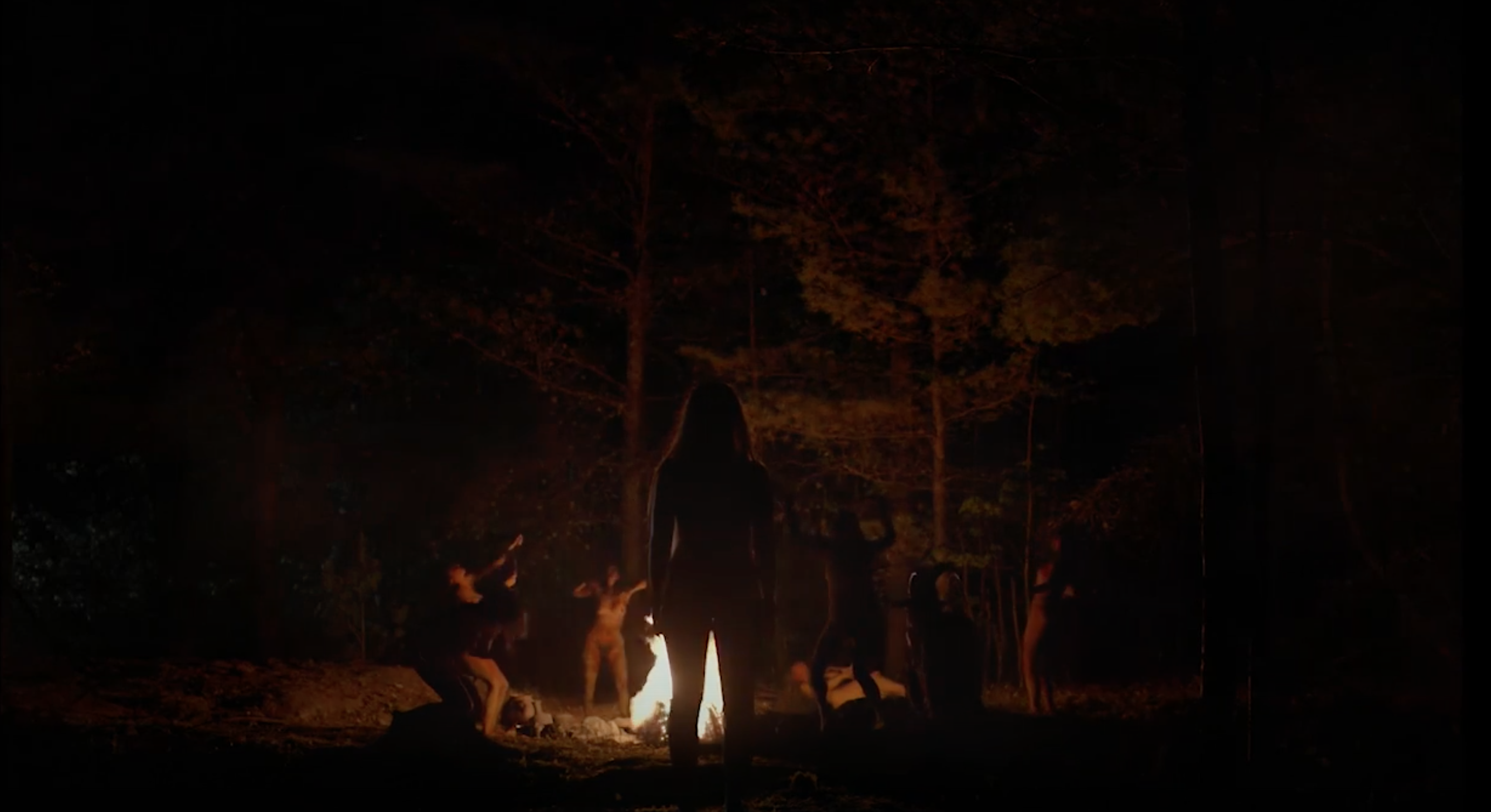 10. Part from 'The Witch' movie, symbolizing the thin layers between (un)real.
10. Part from 'The Witch' movie, symbolizing the thin layers between (un)real.
I relate reality perception to the beholder’s share denoting the part of the artwork that needs an interpretation, contribution of meaning by the audience. Goethe as a beholder, mentions the specter in his Faust written in 1808. He mentions the appearance of a monsterous figure spooking the residents during the Walpurgis night. The residents of the Herz Mountains close to the Brocken Summit believed the area was haunted leading to a series of legends. Demons and dark forces would come here for their annual meeting on the night of April 30th for the Witches Sabbath on Walpurgis Night, which was the turning tide of seasons, the layers between dimensions were the thinnest, being the greatest moment to destroy the barriers between seen and unseen worlds. The specter was a demonic creature, being the source of the need for bonfires to protect the beholders from evil. I consider us as these villagers, beholders in the dark, frightened of what we see trying to cast a light upon the (un)seen world? Phenomena are a sign of the thin layers between realms disguised, illuminating themselves for short moments. I think of it as a dark room, when you have a torch in your hand you catch a glimpse of something which is there, but you can’t see it in the pitch black.
The ConsensusThe experience of the phenomenon in varying locations by various beholders, though still having a resembling depiction, led to new stories besides the ones originating from the Brocken Summit. All the descriptions I read, have the same gloomy, flabbergasted, confused atmosphere around this blurry man hence interpreted with minor distinction. For example, the mystery of the Grey Man also known as Am Fear Liath Mòr in the second highest mountain in Scotland, Ben Macdui. The author touching upon this, Gilly Pickup in his book Paranormal Scotland, questions:
The experience of the phenomenon in varying locations by various beholders, though still having a resembling depiction, led to new stories besides originating ones from the Brocken Summit. All the descriptions I read, have the same gloomy, flabbergasted, confused atmosphere around this blurry man hence interpreted with minor distinction. For example, the mystery of the Grey Man also known as Am Fear Liath Mòr in the second highest mountain in Scotland, Ben Macdui. The author touching upon this, Gilly Pickup in his book Paranormal Scotland, questions:
Could the Big Grey Man be a ghost? ... Brocken Spectre? Yeti-type creature? Ghost? Effects of imaginations enhanced by isolation, dangerous conditions or bad weather? (chp.6)
From the Walpurgis, to the Scottish Am Fear Liath Mor, to Los Vigilantes Oscuros in the Santa Lucia Mountains, to Buddha’s Light in the misty Huangshan Mountains it is clear to me that an experience of an occurrence is an unalike process for one compared to the others. There cannot be one way of being gravely affected. The instances of stories from the same experience carrying out a wide palette of outcomes supports Ponty’s general view on perception, he points out all the knowledge attained comes from one’s specific angle and experience.
Furthermore, what we claim to be objective is agreeing upon a certain pattern. As Anil Seth claims in his TEDX Talk ‘Your brain hallucinates your conscious reality’, the experience of the real is nothing but a controlled hallucination. And if the view we have in our ‘hallucinations’ is the same we agree upon it as factual. We keep on searching for meaning in this random reality. Some beliefs about the specter indicate, we see the enthralling figure because of pareidolia, a condition which pushes the brain to find meaning in randomness and search for patterns in images, an escapism from the blurriness. Human minds describe certain patterns in nature’s forms, involving the same procedure in experiences. Looking at the stories of the specter, there is an undeniable pattern of information in them too. We try to make sense of experiences and grasp the sphere with us in the center, making up stories while glimpsing at the limited dimension that we can optically see.
As a culmination, we use the insight of the world we have is based on the meaning we see in patterns which make it easier to comprehend concepts. I think of science, literature, or any kind of writing as storytelling which is an answer to our question on perception of reality. And all of us have a different answer to the same question, making our own narration out of the illusion that we experience individually. According to Bostrum’s Simulation Argument all minds are in a simulation becoming one meta-experience of a single entity . When we state similar experiences and assent the resemblance, these subjective thoughts become objective thoughts on reality.
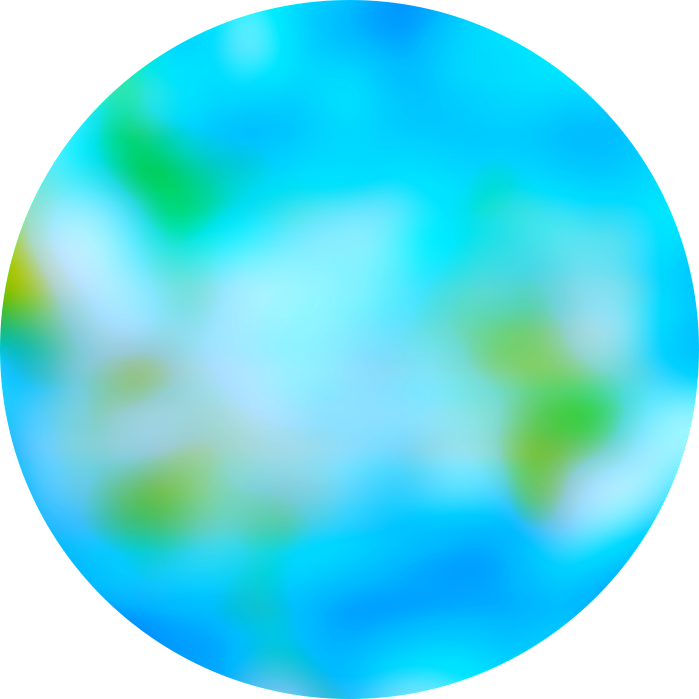
Inside The Cloud
Reality is merely an illusion, although a very persistent one. (Einstein)
Image in DropsWhen you look at the shadow on the mist of the Brocken Specter, all you can see is this huge shadow mimicking you, following you with an egoistic glory around its’ head only visible to you and no one else around you. It seems flat, non-dimensional and coherent as one body. That is what you see, hence it is thousands of water drops refracting the light, maybe if you zoom in you would not see the bigger picture but also would be unable to precisely describe what you see. “What we see, therefore, reflected from the back of the drop is really a magnified image of the sun in colored lights, or, because our position is a fixed one in relation to the falling drops, it is only a part of an image we see in each drop.” (Hunter, 347)
The universe itself is made up from several drops uniting, assembling into one entity, partially perceivable to the human species. In quantum physics, scientists such as Heisenberg claim there is no smooth spacetime. This means that the world is pixelated, the smallest drop it is composed of, is 3D Planck length unit
13
Quantum Gravity Research. “Pixelated vs Smooth Spacetime.” Quantum Gravity Research, 18 Jan. 2021, quantumgravity
research.
org/portfolio/
pixelated-vs-smooth-spacetime..
The physical sphere we see is a flattened 3D image, going through a process known as the gauge symmetry transformation, which originates from the 8D geometrical crystals named E8 lattice.
 11.Representations of an E8 and a Leech Lattice.
11.Representations of an E8 and a Leech Lattice.Lisi, 2007/ Madore, 2019.
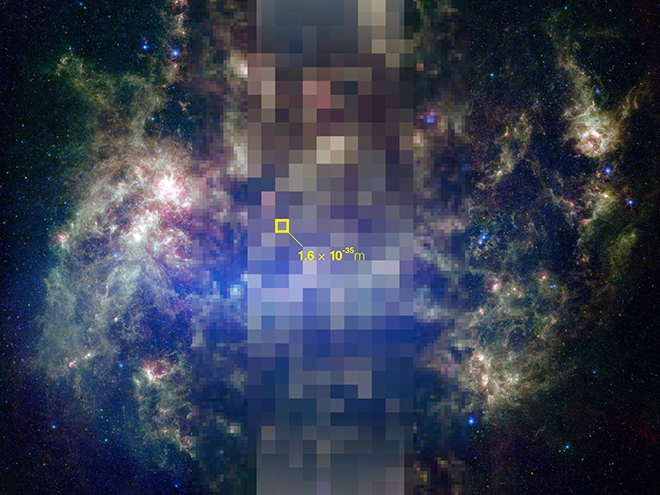 12. NASA's depiction of the universe pixelation.
12. NASA's depiction of the universe pixelation.
Our limits of perception remind me of the six blind men parabola, in which blind man touch an elephant and all try to describe it to each other but as they do not have a clear feel of the whole animal, they all interpret it in diverse ways.“In Buddhism, the tale is used as an example of the uncertainty of human perception, a demonstration of the principle that what we perceive to be true and factual is, in fact, empty of inherent reality.”
14Das, Subhamoy. "The Parable of Six Blind Men and the Elephant." Learn Religions, Aug. 27, 2020, learnreligions.com/
six-blind-men-and-the-elephant-1770380.
Furthermore, if you turn to the source of the specter, the sun, you would be blinded by the bright strokes of light. As a viewer of the specter what you can precisely observe is merely the ironed shadow.
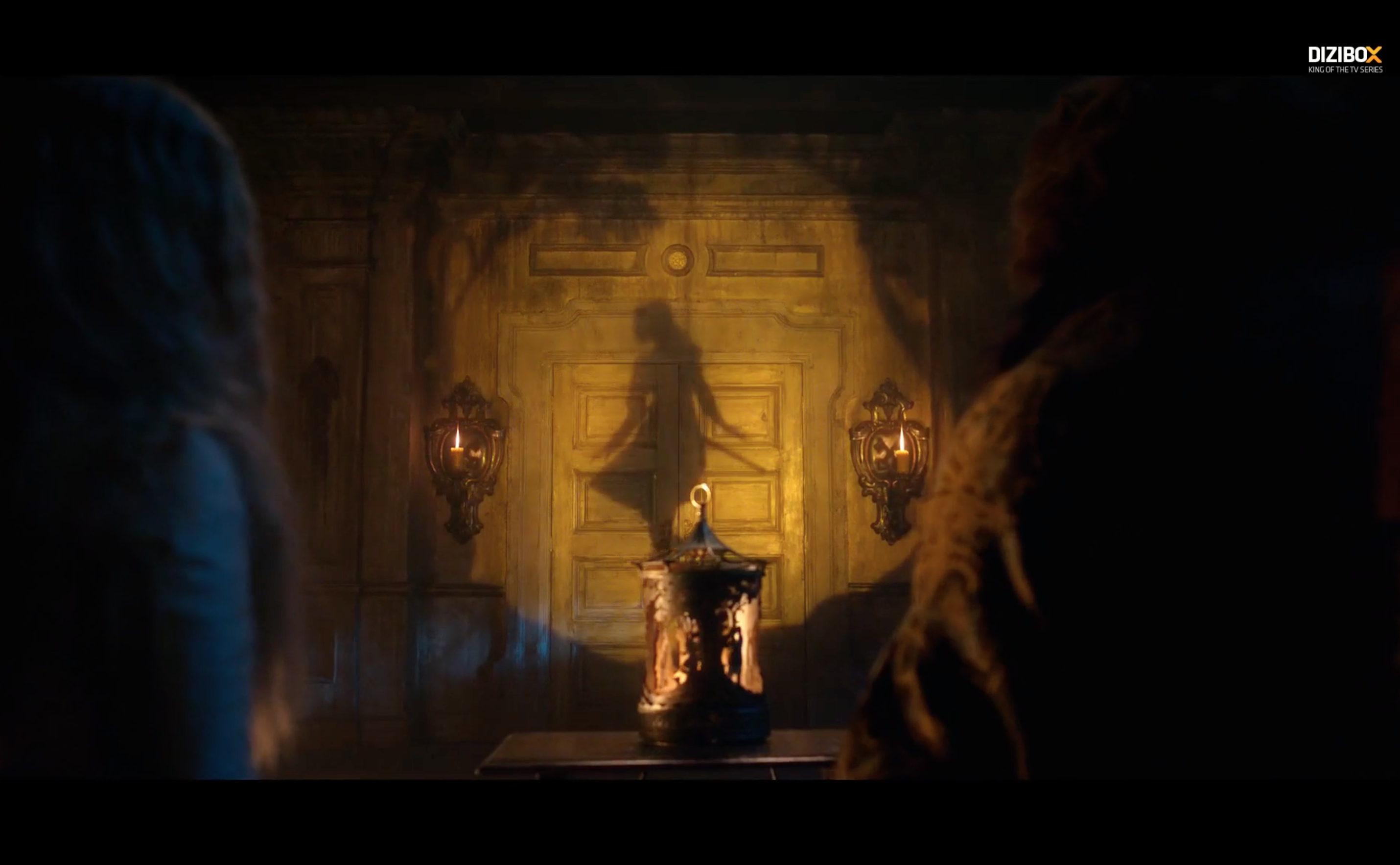 13. A story being told by shadows.
13. A story being told by shadows.
'The Witcher' Eps.01, Season 2.
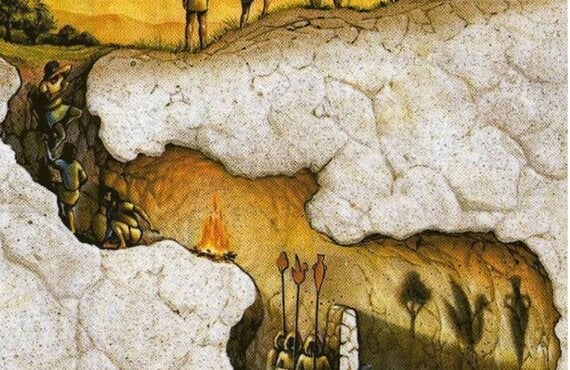 14. Plato's cave.
14. Plato's cave.
In the instance of Plato’s cave , ‘The people’s perception of the world ‘outside’ is shaped through the reflections against the wall they are facing the two-dimensional figures dancing across the stone mark their reality. That is, until one day, one person is forcefully drawn away from the chain, outside the cave. She is blinded by the sudden rush of light, and the knowledge that reality exists beyond shadow-figures overwhelms her.” Socrates suggests that the shadows are reality for the prisoners because they have never seen anything else; they do not realize that what they see are shadows of objects in front of a fire, much less that these objects are inspired by real things outside the cave which they do not see”.
We see the shadows, the specters one may say, of reality and a complete enlightenment of what they really are would be too blinding but still it is such a pity that we wander and wonder. If our whole concept of reality is based on an interpretation of the shadows, which we try to explain with stories and theories, what is out there? Is everything an illusion or a projection?
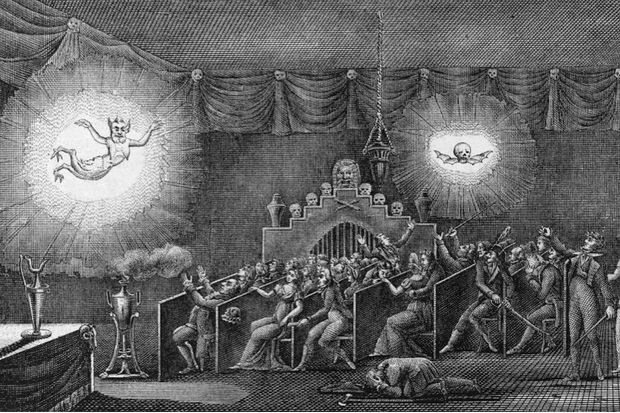 15. Illustation of Phantasmagoria in France.
15. Illustation of Phantasmagoria in France.
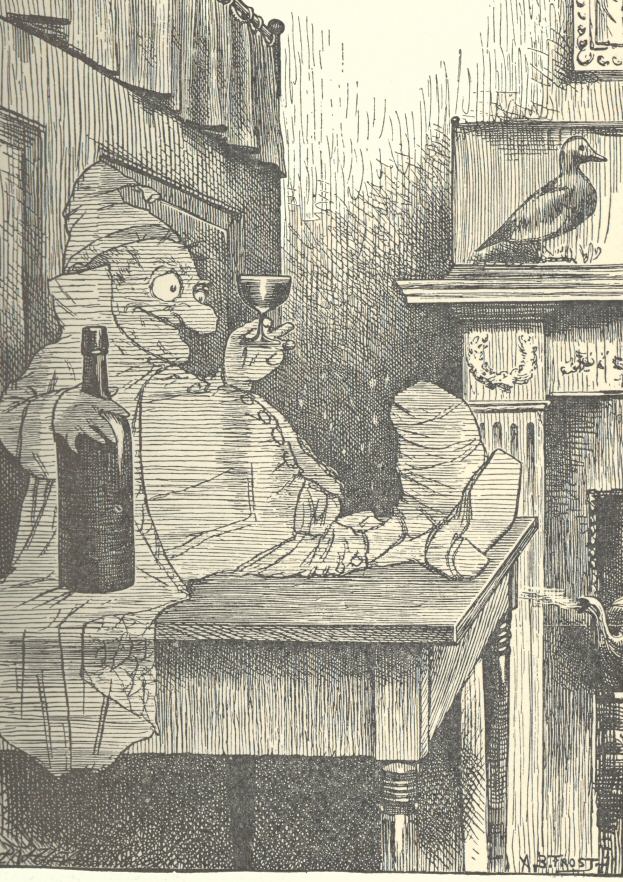 16. Lewis Caroll, Phantasmagoria illustration, p 21.
16. Lewis Caroll, Phantasmagoria illustration, p 21.
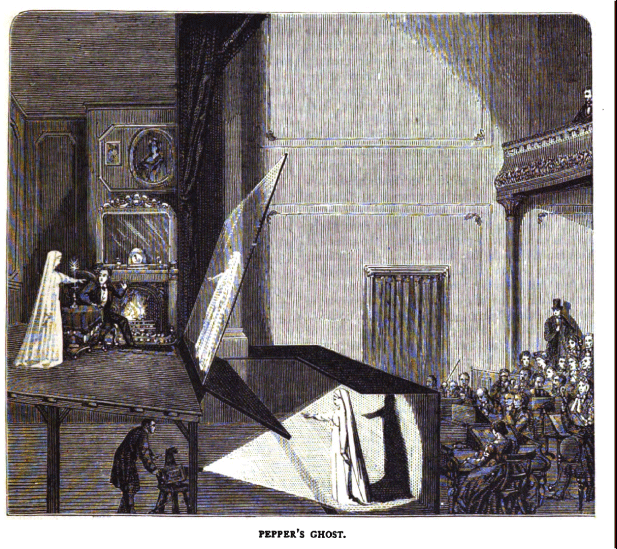 17. Pepper’s illusion in action, from The World of Wonders (1868).
17. Pepper’s illusion in action, from The World of Wonders (1868).
Lewis Caroll touches upon the Brocken Specter in a humorous way mentioning it as a ghost, a shadow in a yellow gown with a night-cap border .This work of Caroll was titled ‘Phantasmagoria’ because of its’ resemblance of creating specters with lanterns and shadows in the theater arts in the 19th century, inspired by the Gothic fiction of the times this raised queries on subjectivity of perception and illusion were raised by philosophers like Kant . The illuminations of ghosts catechized the truthfulness of what can be seen. Magic lights created ghostly figures with an aim of frightening and leaving the ‘inspectors’ flabbergasted. The word phantasmagoria has its’ roots in Greek means ‘summoning of ghosts’ or ‘image-playing.’ The projection of reality being generated as an outcome of our minds is an image play itself. In his book David T. Evans investigates the cultural aspect of phantasmagoria, it was born from an urge to escape reality. The viewers were forced to stay during the spooky performance while using substances such as alcohol and drugs. 15 Evans, David. Phantasmagoria: Sociology of Opera (Routledge Revivals). 1st ed., Routledge, 2020. What we perceive as reality is a playful composition of layers, dimensions, images, surfaces that only exists when observed.
A Specter's BackstageAlthough we have access to the specter of reality through our two optical lenses, the backstage of the image created remains a mystery. Throughout history there have been speculations on how the image of the world we experience forms. One of the theories related more to the biological progress of human species evolution is presented by Blumenbach who touches upon the formative drive/force. He claims that there is a force in all organisms which leads to their final form. “Cause (unknown) – produces > force (the Bildungstrieb) – produces > perceptible effects (e.g., Epigenesis.)”. I think the same way about the construction of the visible universe. There is a certain force which creates the realm we endure in. A shadow can’t form without a light source, hence also without a viewer. An occurrence doesn’t exist without a creator, by creator I’m not reffering to a God or a person specifically but an (in)visible energy resulting in an experienceable outcome.
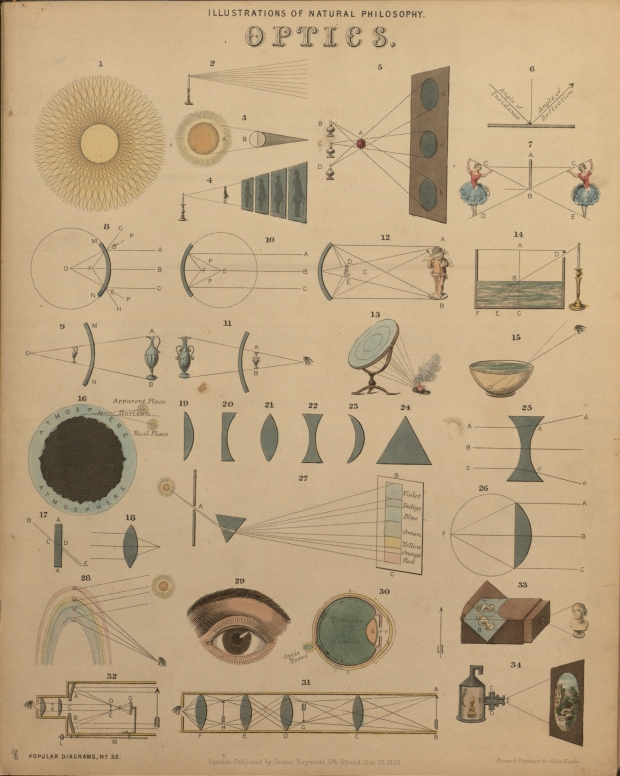 18. Optics.
18. Optics.
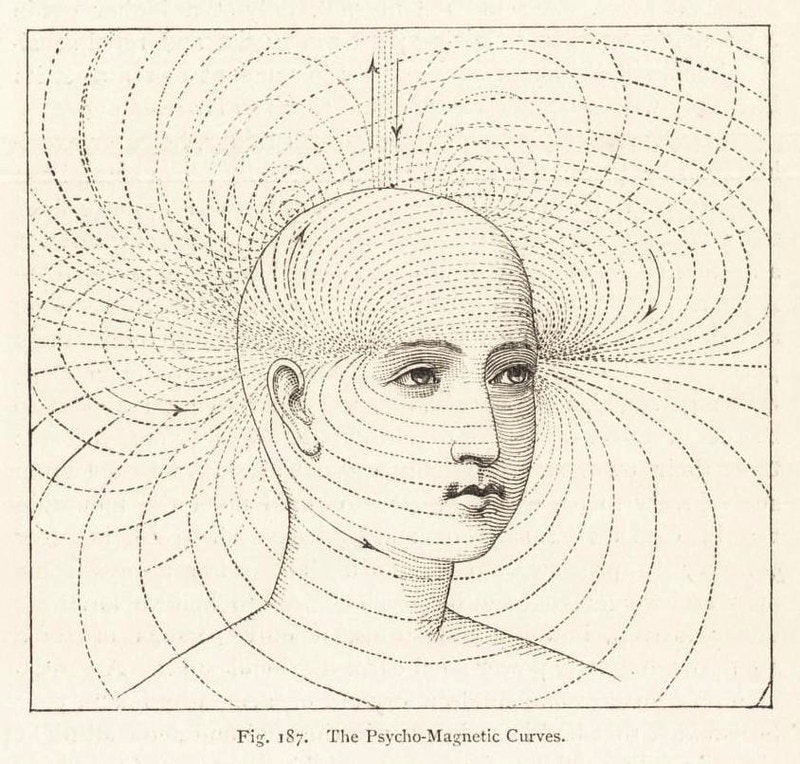 19. Illustration from Edwin D. Babbitt's The Principles of Light and Color (1878).
19. Illustration from Edwin D. Babbitt's The Principles of Light and Color (1878).
Moreover, as the investigators of this outcome - the shadow, we have created new ‘optical lenses’ based on the ones which are a part of our biology. The need for those technologies comes from the lack of precision and limitations of our eyes. Cameras, telescopes, microscopes, glasses, goggles, magnifying glass, mirrors, light prisms, achromatic lenses … All those tools and instruments serve the purpose of revealing the details we can’t see. On one hand, they are very beneficial in scientific investigations but on the other I personally question their liability. In the end, we look through those lenses through our natural lenses and we are the creators of them. Where does the certainty of them presenting the actuality correctly come from? The vision available through the lenses could be even more crooked than what our eyes see because it’s a translation to another medium, once again left for our interpretation and perception. It’s uncanny and disorienting to rely on our senses and what has been constructed by the humankind. The purpose of optical instruments is bolstering the sight ability.
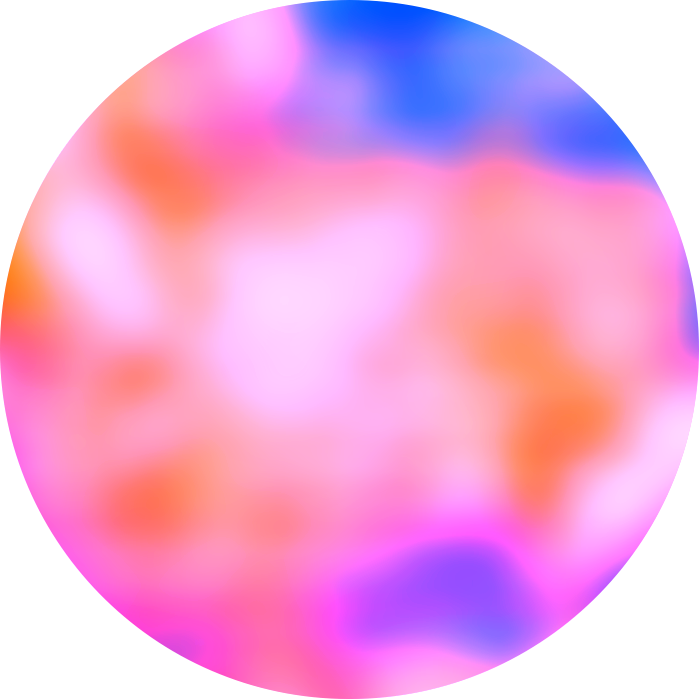
Beyond The Cloud
Is the universe holographic? Probably. Get microscopic enough and you start seeing pixels.16 Erikson, Steven. Rejoice, a Knife to the Heart. Promontory Press Inc., 2018.(Samantha August)
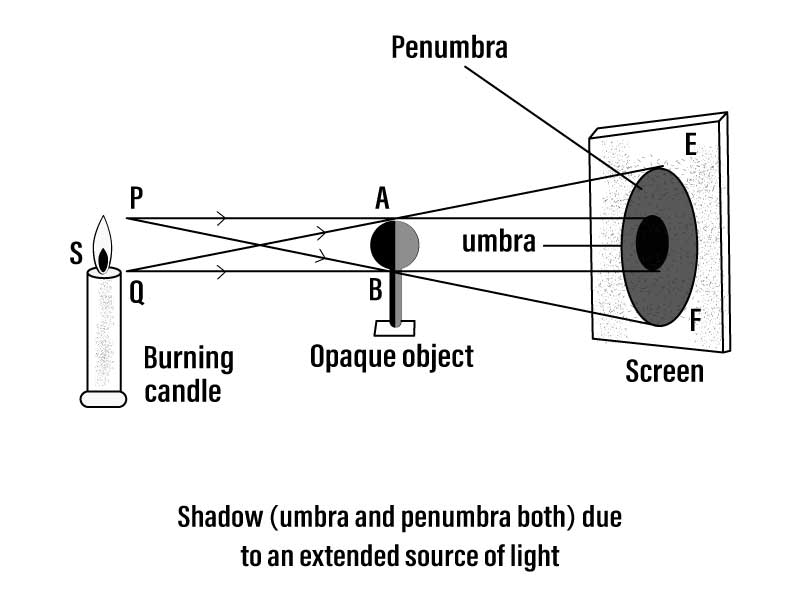 20. Graph showcasing the spread of the shadow.
20. Graph showcasing the spread of the shadow.
 21. Image of the whole visible universe.
21. Image of the whole visible universe.
Brocken Translation
The digital realm, or this new dimension we build showcases a translation of our perception of the physical world. It is like the penumbra of the umbra, a shadow of a shadow. The amalgam of the human ability-based construction of our surrounding with the technological tools created causes a new specter. The illusion existing in a new layer, but physically present within our screens and other portals, is a result of the limitations at our disposal. This teleportation of the realm perceived - into a new realm, constructs even a more broken image of reality than the actual one. I see our approach of composing a digital dimension quite hazardous, as it lacks the truthfulness due to our not-so-accurate perception of reality. It is not possible to reflect the reality which we don’t exactly comprehend into a new one and this results in flaws. It becomes a vicious cycle, not understanding what we see, hence translating what we see, and seeing the result of it isn’t seeing what is there to be seen.
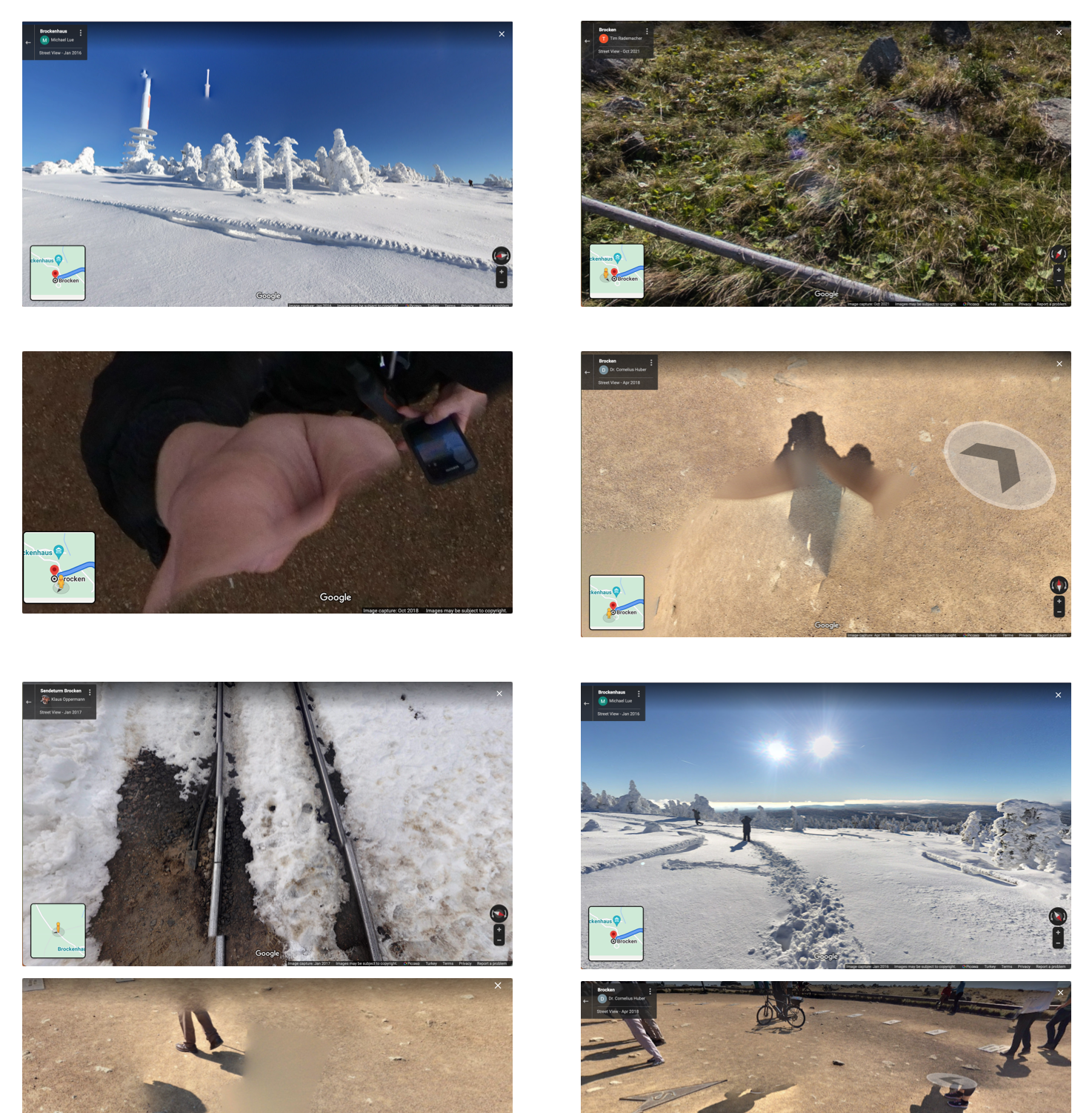 22. Google Maps screenshots of broken parts in the Bro(c)ken Summit.
22. Google Maps screenshots of broken parts in the Bro(c)ken Summit.
Looking in depth of the Brocken Specter, I came across the Google Maps 360 view of the summit in the Herz Mountains. The inaccuracy and the crocked images of the space have a certain resemblance to the occurrence itself, some illusions caused by the inefficiency of the optical lenses. Double sun, a floating tower top, broken train rails, half bodies, and weird shadows. Google Maps is one of many instances of the conveyance of the physical world. As the senior product manager Malik Gupta states "Increasingly as we go about our lives, we are trying to bridge that gap between what we see in the real world and [the online world], and Maps really plays that part."
17
Madrigal, Alexis. “How Google Builds Its Maps—and What It Means for the Future of Everything.” The Atlantic, 10 Jan. 2017, www.theatlantic.com/
technology/archive/
2012/09/how-google-builds-
its-maps-and-what-it-means-for-the-future-of-everything/261913.
But whilst trying to construct this bridge, striving for perfectionism with thousands of brains working on it, I think this gap won’t ever be filled, we just don’t have the capacity for it. The images from the Brocken Summit are very clear distortions, the deep map has many other deep flaws; incorrect sizing due to the use of Mercator projection
18
The Mercator projection creates increasing distortions of size as you move away from the equator. As you get closer to the poles the distortion becomes severe.
(ex: Greenland Problem ), glitches, lacking information.
Moreover, we can’t see many of the layers in Google Maps which are in the backstage, the algorithm, turn restrictions, street connection calculations. Once again as a spectator just a part of a realm is presented to us. However, what differentiates it from the Brocken Specter phenomenon is that in this instance the human is both the spectator and creator. We change our position in this equilibrium of reality. In the natural occurrence, we are positioned in between the Sun and the Mist, we are interpreting the shadow whilst now we replace ourselves with the Sun creating the shadow. Switching from a stereoscopic view to a combination of the panoramic and bird view. The human becomes the sun, the source, the force. It is some sort of feedback loop, were the constructor, interpreter is the same subject as the spectator.
The Unrealm
In the The Geographical Journal the Specter of Brocken is mentioned as ‘an imprint of human on the cloud’
19
“Annual General Meeting 2 June 2003.” The Geographical Journal, vol. 169, no. 3, [Wiley, Royal Geographical Society (with the Institute of British Geographers)], 2003, pp. 283–90, http://www.jstor.org/
stable/3451454..
We make use of the digital cloud in our daily lives, leaving imprints and traces like the shadows on the mists. One of the milestones of expanding our simulated, floating reality was the launch of the internet in the 1980s, giving birth to cyberspace
20
Backhtiari, Kian. “Welcome To Hyperreality: Where The Physical And Virtual Worlds Converge.” Forbes, 30 Dec. 2020, www.forbes.com/
sites/kianbakhtiari/
2021/12/30/
welcome-to-hyperreality-where-the-physical-and-virtual-worlds-converge..
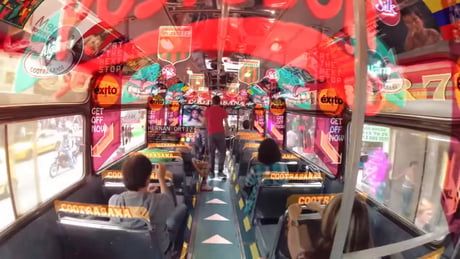 23. Hyperreality, where simulacra overlaps the real and becomes the new reality.
23. Hyperreality, where simulacra overlaps the real and becomes the new reality.
This opened a new window to the realm of the unknown, yet an illusionary reproduction out there for the human consciousness to investigate, all compressed into a cloud. The way we start perceiving everything on this cloud, like Google Maps as the actuality and the blend between the realms is a trickery. With time it becomes hard to distinguish the real and unreal. A mutated version and a copy of the actuality seeming truer than the original reality. Borges who questions the value of this sort of abstraction touches upon an old story about an empire which strives for the precise translation of the actuality into a map, the group of cartographers make a map the size of the land itself, seeing its useless they leave it in the sun
21
Mehaffy, Michael W., and Nikos Angelos Salingaros. ""On Exactitude in Science", by Jorge Luis Borges. - Appendix to Chapter 15." In Design for a Living Planet: Settlement, Science, & the Human Future, 221-223. DFLAP. Levellers/Sustasis Press and Vajra Publications, 2015..
The map becomes the reality as it is inhabited by organisms. Our screens containing a non-molecular dimension come to live as we use them.
Henceforth, as the actuality starts blending with the representation of itself, going through several processes of interpretations and perception in our brains, the inextricability of senses and the disorientation gains power. This intensification of confusion on this illusion, leaves us with the dilemma of what is real. The complexity of making a distinction and the new existing layer, neither the real nor the unreal becomes the hyperreal.
22
MAMBROL, NASRULLAH MAMBROL. “Concept of Hyperreality.” Literariness.Org, 2016, literariness.org/2016/
04/03/baudrillards-concept-of-hyperreality.
The term hyperreality was first mentioned by the French theorist Jean Baudrillard, who highlighted the position of society in the postmodern world. Nowadays, the society resides in hyperreality, a sphere composed of the simulacra - representations, signs, portraits, signifiers of the real. The hyperreal is a threat to the imaginary and the actuality. When the realms merge in the uncanny state, cognitive closure which we are thirsty for becomes unreachable. Representations and entities without the origin of the real, grow their own power.
For instance, the search for the Higgs boson
23
Lederman, Leon, and Dick Teresi. The God Particle: If the Universe Is the Answer, What Is the Question? Reprint, Mariner Books, 2006.
(in English God’s particle) by CERN or research on dark matter by the Max Planck Institut in Germany, resulted in the Millennium Simulation.
completed in 2015.
24
“Millennium Simulation Project.” Mpa.Mpg.De, wwwmpa.mpa-garching.mpg.de/
galform/virgo/
millennium.
The simulation portrays the blank space structure surrounding us and is a very thin slice of the whole cake. It is a visualization of the details invisible to human eye in the space surrounding us, the dark matter. Combining this image with what we see leads to a certain way of thinking. Simulation merges with reality constructing a new meaning or a representation in our minds. This simulation, as a scientific explanation of something beyond our sense of sight, seems true and real enough to believe in.
At this point in our century, tech progression and expanding precision of the facsimile of reality ends in a scrambled, warped perception of reality (as if it wasn’t warped enough). The specter in our screens starts taking over the physical world which is a new phenomenon starting to thrive. Resembling to the natural one, it mesmerizes and indulges us. We follow an illusion of reality blindly.
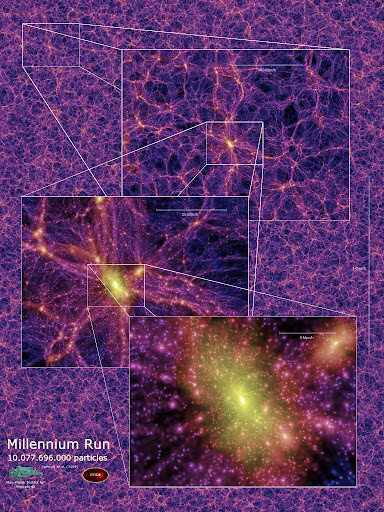 24. Max Plank Institute, Gemany, Millenium Run Project.
24. Max Plank Institute, Gemany, Millenium Run Project.
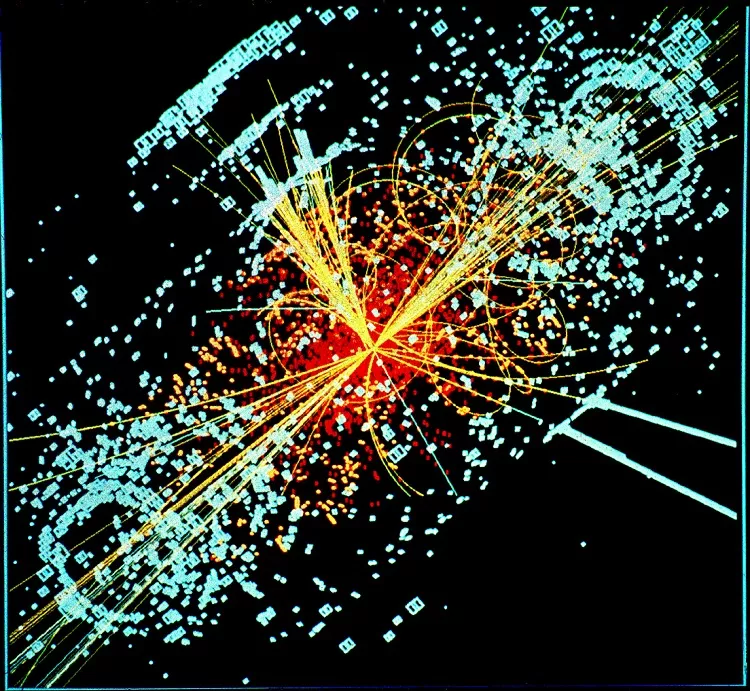 25. CERN, Simulated data from the Large Hadron Collider particle detector shows the Higgs boson produced after two protons collide.
25. CERN, Simulated data from the Large Hadron Collider particle detector shows the Higgs boson produced after two protons collide.
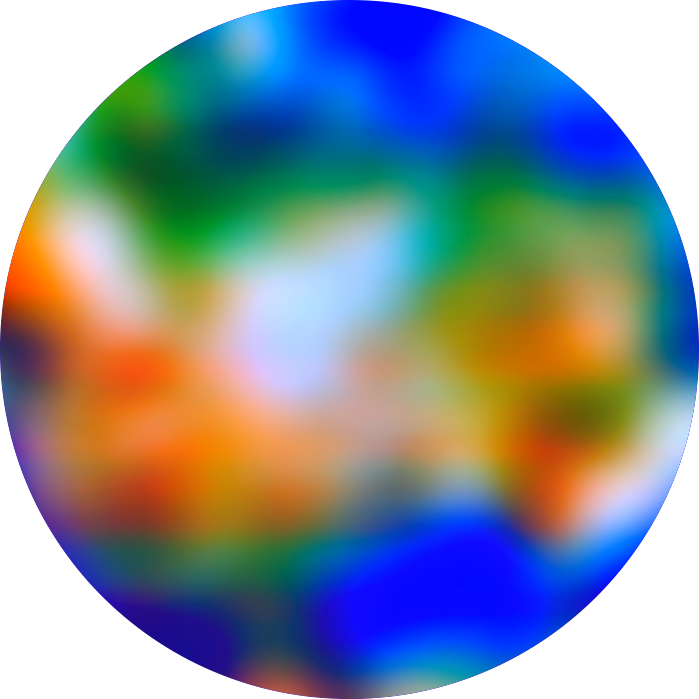
The Spectrum of A Droplet
Being the same species, you and I, see the world through the same kind of aperture, our pupils. However, there are several veneers of perceiving reality. The position which you are in whilst an experience, your inner consciousness, the lenses you gaze through, your limitation of sight. The perception of reality is dependent on several factors creating a disorientation of stating one accurate view. The physical realm is an image play, phantasmagoria, a phenomenon filled with illusive and luminous trickery, an experience left for our subjective interpretation as the beholders. It is a playground of shapes and colors, in which our consciousness constructs its’ own reality, like a child. We interpret, narrate, form realities in our own stereotropism bubbles. Nonetheless if we consider all interpretations of an experience as one entity like Bostrum claims, we collectively form an anisotropic view with an emergence for consensus. The objective perspective on reality is an agreement of our pareidolic stories, discoveries of patterns in our delineations of experiences.
Through our lenses, we stare at the universe and it’s like the Brocken Specter, composed of drops which we don’t particularly see hence we see the composition, only if you zoom in you see the pixels. The universe realm is a huge projection flattened by our senses into merely a shadow. Intrinsic nature of reality is in our blind spot, the unreachable architect in the mist. Wonders and mysteries of reality keep disclosing themselves for short spans of time, logically all images displayed in front of us, have a source as there can’t be a reaction without action. What is in the backstage of the specter of reality? And here we start coming up with explanations to the unknown, attempting to fill the gap between the mind, the eyes and the drops.
The haziness of the reality and the urge to bring the uncertain to a halt, pushes humanity to manufacture (optical and other) mechanisms with abilities our biology lacks. In my opinion, our perception is unreliable and so are the tools which we give birth to aiming for cognitive closure. Translation of a not fully comprehendible world through different mediums or portals, breaks the brokenly perceived world even more. It becomes a reflection of a reflection of a reflection… A loop of destroying the actual realm, in which at some point the root can’t be seen anymore, the original drop dissolves. As the most developed occupants of the eerie and uncanny sphere, we easily get lost in the dilemma of unreal and the real. In the interconnected mess of newly emerged dimensions which we are Gods of and the mysterious natural phenomena, it becomes impossible to distinguish illusions as the illusions themselves become reality. In this century, the blend of the original existences and simulacra is one merged, inseparable body of droplets which becomes a perilous mist.
In conclusion, we don’t perceive our reality, but the reality is what we perceive. I started my research with the Brocken Specter because I was mesmerized by the phenomenon and illusion it structures. It’s just an instance, looking at the broader spectrum of droplets, I think that we live in an illusion or maybe reality is some sort of simulation created by the spectators themselves.
I’m the actor and director of this image play of my encompassment. The egoistic halo of the Brocken Specter is visible only to the main beholder. My reality is what is born from my perception and isn’t viewed the same way by others. My eyes are the only optical lenses I attain naturally.With tools I have access to like lenses I can enhance my sight hence my eyes look through them. These tools can give me a clarity to the view however they will add new errors, new illusions. As a designer I have the opportunity to create illusions myself based on the interpretations of my personal perception.
I see a specter of the things that lie beyond my capacity.
I see the fractured layers of illusions, simulations, realms, celestial bodies, portals fusing.
I see a fractured or bro(c)ken perception of reality.
I perceive a reality assembled of the spectrum of a droplet.

Works Cited
“Annual General Meeting 2 June 2003.” The Geographical Journal, vol. 169, no. 3, [Wiley, Royal Geographical Society (with the Institute of British Geographers)], 2003, pp. 283–90, http://www.jstor.org/stable/3451454.
Armstrong, Paul B. “Phenomenology: Architecture, Body and Performance.” Edition 2, 2015, pp.1, https://www.brown.edu/Departments/Joukowsky_Institute/courses/architecturebodyperformance/1065.html
Caroll, Lewis. Phantasmagoria, by Lewis Carroll. Macmillan and Co., London, www.gutenberg.org/files/651/651-h/651-h.htm.
Erikson, Steven. Rejoice, a Knife to the Heart. Promontory Press Inc., 2018.
von Goethe, Johann Wolfgang.“Faust”. Translated by W. Kaufman, Anchor Books, 1962.
Heisenberg, Werner. “Physics and Philosophy: The Revolution in Modern Science”. Harper Perennial Modern Classics, (1928),8 May 2007. Print.
Hunter, A.F. “Rainbows, Fogbows and Their Associated Phenomena”. NASA Astrophysics Data System (ADS),December 1921. Journal of the Royal Astronomical Society of Canada, Vol. 15, p.347.
Husserl, Edmund. “Introduction to Phenomenological Psychology” (MR 5-6).1928.
Meraud,Tavi.”Iridescence, Intimacies”. E-flux, January 2015. www.eflux.com/journal/61/60995/iridescence-intimacies/
Merleau-Ponty, Maurice. “ Phénoménologie De La Perception” (in English: Phenomenology of Perception). Edition Taylor & Francis e-Library, Translated by Routledge. Library of Congress Cataloging in Publication Data, 2004. pp. IX.
Muzdakis, Madeleine. "‘Brocken Spectre’ Is A Rare Yet Beautiful Optical Phenomenon Of A Radial Rainbow". My Modern Met, 2021, mymodernmet.com/brocken-spectre/.
Möller, Detlev. “Zur Geschichte der wissenschaftlichen Erforschung von Nebel, Tau, Regen und anderem Atmosphärenwasser” (in English: On the History of the Scientific Exploration of Fog, Dew, Rain and Other Atmospheric Water). Special Issue: Fog Research, DIE ERDE 139, Cottbus, 2008. pp.11.
Pickup, Gilly. “Paranormal Scotland”. Amberley publishing, 2020.
Seth, Anil. “Your brain hallucinates your conscious reality”. 8 July 2017. TED Talks, Sussex.
Silberschlag, Johann Esaias. n.t, n.p,1780. https://dbpedia.org/page/Johann_Silberschlag
Thomson, Heidi. “Coleridge and the Romantic Newspaper: The 'Morning Post' and the Road to 'Dejection'”, Palgrave Macmillan, 2016, pp. 242.
U.S. Navy. “Aerographer’s Mate: Module 1 - Surface Weather Observations”. N.p :CreateSpace Independent Publishing Platform, 3 January 2011. Print
Verderame, Michael. Studies in Romanticism, vol. 52, no. 1, Boston University, 2013, pp. 147–50, http://www.jstor.org/stable/24247323.
Books & e-books
1. Wright, C. J. “The ‘Spectre’ of Science. The Study of Optical Phenomena and the Romantic Imagination.” Journal of the Warburg and Courtauld Institutes, vol. 43, Warburg Institute, 1980, pp. 186–200, https://doi.org/10.2307/751195.
2. Richards, Robert J. “Kant and Blumenbach on the Bildungstrieb: A Historical Misunderstanding”. Elsevier Science Ltd, 2000. http://home.uchicago.edu/rjr6/articles/Kant%20and%20Blumenbach.pdf
3. Lewis, Peter. "Dimension And Illusion". Oxford Scholarship Online, 2022. https://oxford.universitypressscholarship.com/view/10.1093/acprof:oso/9780199790807.001.0001/acprof-9780199790807-chapter-5
4. Considine, Douglas M, and Glenn D Considine. “Van Nostrand's Scientific Encyclopedia”. Springer, 2013, pp. 2538.
5. Stableford, Brian M. “Science Fact and Science Fiction: An Encyclopedia”. Taylor & Francis, 2016. pp. 344.
6. William R. Corliss, “The Handbook of Unusual Natural Phenomena”. Sourcebook Project; First Printing edition, 1 Jan. 1977.
7. O’Grady, Steve. Right Back At You: Being Human in a Simulated Universe. ShieldCrest Publishing Ltd, 2019.
8. Mulder, Frank. Hyperreality: How Our Tools Came To Control Us. Resource Publications, 2021.
9. Lederman, Leon, and Dick Teresi. The God Particle: If the Universe Is the Answer, What Is the Question? Reprint, Mariner Books, 2006.
10. Caroll, Lewis. Phantasmagoria, by Lewis Carroll. Macmillan and Co., London, 20.
11. Peterson, Michael. Mapping in the Cloud. 1st ed., The Guilford Press, 2014, 107.
Websites & Articles
12. Byrd, Deborah. "What Is The Brocken Spectre?". Earthsky | Updates On Your Cosmos And World, 2019, https://earthsky.org/earth/what-is-the-brocken-spectre/.
13. Hartley, Dr. Helen. "Brocken Spectres And Circular Rainbows". Kew.Org, 2016, https://www.kew.org/read-and-watch/brocken-spectres-and-circular-rainbows.
14. Konnikova, Maria. "Why We Need Answers". The New Yorker, 2013, https://www.newyorker.com/tech/annals-of-technology/why-we-need-answers.
15. Meraud, Tavi. "Iridescence, Intimacies - Journal #61 January 2015 - E-Flux". E-Flux.Com, 2015, https://www.e-flux.com/journal/61/60995/iridescence-intimacies/.
16. Suttie, Jill. "Eight Ways Your Perception Of Reality Is Skewed". berkley.edu, 2020, https://greatergood.berkeley.edu/article/item/eight_reasons_to_distrust_your_own_perceptions.
17. Kiger, Patrick J. "'Pilot's Glory': Why A Rainbow Encircles An Airplane Shadow On Clouds". Howstuffworks, 2015, https://science.howstuffworks.com/nature/climate-weather/atmospheric/pilots-glory-rainbow-airplane-shadow.htm
18. Hitt, David. "What Are Clouds?". NASA, 2017, NASA Educational Technology Services, https://www.nasa.gov/audience/forstudents/k-4/stories/nasa-knows/what-are-clouds-k4.html.
19. Robins, Becky. "Ancient Explanations For Natural Phenomena". Grunge.Com, 2022, https://www.grunge.com/134547/ancient-explanations-for-natural-phenomena/.
20. Murphy, Douglas B. et al. "Principles Of Birefringence". Nikon’S Microscopyu, 2022, https://www.microscopyu.com/techniques/polarized-light/principles-of-birefringence.
21. Kurenniemi, Erkki. "Experiments In Eternity". E-Flux.Com, 2017, https://www.e-flux.com/journal/85/155474/experiments-in-eternity-erkki-kurenniemi/
22. Sommers, Jeffrey. "Romanticism In Literature: Definition And Examples". Thoughtco, 2019, https://www.thoughtco.com/romanticism-definition-4777449.
23. Conrad, Tessa. "Virtual Reality Is, Finally, The New Reality". The Drum, 2021, https://www.thedrum.com/opinion/2021/06/04/virtual-reality-finally-the-new-reality.
24. Tschackert, P. "Deutsche Biographie - Silberschlag, Johann Esaias". Deutsche-Biographie.De, 2015, https://www.deutsche-biographie.de/sfz80294.html.
25. von Etappen-Wandern, Romy. "Brockengipfel (Höchster Punkt Sachsen-Anhalt) Routes For Walking And Hiking | Komoot". Komoot, 2021, https://www.komoot.com/highlight/68837.
26. Black, Annetta. "Teufelskanzel & Hexenaltar". Atlas Obscura, https://www.atlasobscura.com/places/teufelskanzel-hexenaltar.
27. Iversen, Margret. “Alois Reigl, Art History and Theory”. Mitt Press, 2003. https://mitpress.mit.edu/books/alois-riegl
28. Wegner, Stephen. “Walpurgis-The Other Halloween”. Liveabout, 2017. https://www.liveabout.com/walpurgis-night-the-other-halloween-2595375
29. Jones, Polyna. “Am Fear Liath Mòr: A Scottish Terror”. Exemplore, 2020. https://exemplore.com/cryptids/Am-Fear-Liath-Mr-aScottish-Terror
30. De Abreu, Kristine. “Natural Wonders: Brocken Spectre”. Explorer’s web, 2021. https://explorersweb.com/natural-wonders-brocken-spectre/
31. Cohen, S. Marc. “Aristotle On Perception”. Washington.edu, 2008. https://faculty.washington.edu/smcohen/433/PerceptionLecture.pdf
32. Rose, Frank. “The Art of Immersion: Why Do We Tell Stories?” Wired, 8 Mar. 2011, www.wired.com/2011/03/why-do-we-tell-stories.
33. Das, Subhamoy. "The Parable of Six Blind Men and the Elephant." Learn Religions, Aug. 27, 2020, learnreligions.com/six-blind-men-and-the-elephant-1770380.
34. Evans, Elinor. “Phantasmagoria: Creating the ‘Ghosts’ of the Enlightenment.” HistoryExtra, 24 Nov. 2021, www.historyextra.com/period/stuart/phantasmagoria-creating-the-ghosts-of-the-enlightenment.
35. Allegory of the Cave. faculty.washington.edu/smcohen/320/cave.htm.
36. Bakhtiari, Kian. “Welcome To Hyperreality: Where The Physical And Virtual Worlds Converge.” Forbes, 30 Dec. 2020, www.forbes.com/sites/kianbakhtiari/2021/12/30/welcome-to-hyperreality-where-the-physical-and-virtual-worlds-converge/?sh=71d44b8a5028.
37. Roberts, Mark S. “From the Arcades to Hyperreality: Benjamin and Baudrillard.” International Journal of Baudrillard Studies, 2008, baudrillardstudies.ubishops.ca/from-the-arcades-to-hyperreality-benjamin-and-baudrillard.
38. Gill, Serena. “Introducing Jean Baudrillard’s Concept of Hyperreality.” Medium, 14 Dec. 2021, medium.com/desertofthereal/introducing-jean-baudrillards-concept-of-hyperreality-3ec73df477eb.
39. Poster, Mark. “Baudrillard_Simulacra and Simulations.” Stanford.Edu, Stanford University Press, 1998, web.stanford.edu/class/history34q/readings/Baudrillard/Baudrillard_Simulacra.html.
40. “Reality, Hyperreality (1).” Uchicago.Edu, csmt.uchicago.edu/glossary2004/realityhyperreality.htm. Accessed 8 Feb. 2022.
41. Springel, Volker. “Millennium Simulation.” Mpa-Garching.Mpg.De, wwwmpa.mpa-garching.mpg.de/galform/press. Accessed 8 Feb. 2022.
42. “SIMULATION THEORY (Documentary) - Is Reality Simulated?” YouTube, uploaded by metaRising, 26 Mar. 2021, www.youtube.com/watch?v=zmRTC6xhis4.
43. “Johann Friedrich Blumenbach (1752–1840) | The Embryo Project Encyclopedia.” Asu.Edu, embryo.asu.edu/pages/johann-friedrich-blumenbach-1752-1840. Accessed 8 Feb. 2022.
Images
1.https://external-preview.redd.it/S7CZQ1WqfIoZs4TgTGQVPMhOZANWpg_A8u8onu6MFRw.jpg?auto=webp&s=d85988b43ede6e8ddc2e06c7e08db156fb661bf7
2.https://ninaseale.files.wordpress.com/2015/05/andrew-arg_flickr.png?w=600&h=362
3.http://www.caelumobservatory.com/obs/brockenspectre.html
4. http://www.weatherscapes.com/Graphics/Techniques/Brocken/w-375-36.jpg
5. https://assets.atlasobscura.com/media/W1siZiIsInVwbG9hZHMvcGxhY2VfaW1hZ2VzLzZlOGNlYjMyZTg5ZjJhZTdhM19TY3JlZW4gU2hvdCAyMDEzLTEwLTI0IGF0IDkuMzYuMTMgUE0ucG5nIl0sWyJwIiwidGh1bWIiLCJ4MzkwPiJdLFsicCIsImNvbnZlcnQiLCItcXVhbGl0eSA4MSAtYXV0by1vcmllbnQiXV0
6.Great Disasters and Horrors in the World's History, c.1890
http://thenonist.com/images/uploads/brcknspctr1.jpg https://books.google.nl/books?id=PQAGSA5BQdQC&dq=brocken+specter&source=gbs_summary_s&redir_esc=y
7.Darstellung des Brockens von L. S. Bestehorn aus dem Jahr 1732
https://s3.us-west-2.amazonaws.com/secure.notion-static.com/d65ba0c9-ab11-444c-9048-0a1e42f83995/540px-Brocken_L._S._Bestehorn.jpg?X-Amz-Algorithm=AWS4-HMAC-SHA256&X-Amz-Content-Sha256=UNSIGNED-PAYLOAD&X-Amz-Credential=AKIAT73L2G45EIPT3X45%2F20220209%2Fus-west-2%2Fs3%2Faws4_request&X-Amz-Date=20220209T153125Z&X-Amz-Expires=86400&X-Amz-Signature=28b417fab5759745d9fa238fa31f6f25d5dfbaf3415260f2d8acc02cc7231bef&X-Amz-SignedHeaders=host&response-content-disposition=filename%20%3D%22540px-Brocken_L._S._Bestehorn.jpg%22&x-id=GetObject
8.https://i.pinimg.com/564x/44/5f/1a/445f1a06008c4112c6e9287adcc89332.jpg
9.https://static.tvtropes.org/pmwiki/pub/images/walpurgisnacht.jpg
10.https://www.youtube.com/watch?v=ZD8XT9_egAA
11.Representations of an e8 and a Leech Lattice (Lisi, 2007) (Madore, 2019).
https://www.researchgate.net/figure/Representations-of-an-e8-and-a-Leech-Lattice-Lisi-2007-Madore-2019_fig2_344512606
12.https://www.wired.com/2014/11/planck-length/
13.The Witcher, s2 e1
14.https://blogs.ed.ac.uk/s2119138_issues-and-concepts-in-digital-society-2020-2021sem1/wp-content/uploads/sites/3235/2020/10/People-climbing-out-of-a-cave.jpg
15.https://images.immediate.co.uk/production/volatile/sites/7/2018/01/GettyImages-81684830-2-964a0dd.jpg?webp=true&quality=90&resize=620%2C413
16.Lewis Caroll, Phantasmagoria illustration p 21
https://www.gutenberg.org/files/651/651-h/651-h.htm
17.Pepper’s illusion in action, from The World of Wonders (1868).
https://skullsinthestars.com/2016/12/20/dircks-and-pepper-a-tale-of-two-ghosts/
18.https://romantic-circles.org/gallery/illustrations-natural-philosophy-plate-no-32
19.Illustration from Edwin D. Babbitt's The Principles of Light and Color (1878)
https://s3.us-west-2.amazonaws.com/secure.notion-static.com/8b65dc9f-eb1d-4eb0-bd43-f87342454316/33474493220_9f814da9f9_c.jpg?X-Amz-Algorithm=AWS4-HMAC-SHA256&X-Amz-Content-Sha256=UNSIGNED-PAYLOAD&X-Amz-Credential=AKIAT73L2G45EIPT3X45%2F20220209%2Fus-west-2%2Fs3%2Faws4_request&X-Amz-Date=20220209T161521Z&X-Amz-Expires=86400&X-Amz-Signature=c4b4113ec033a446dce95b71b96c45ca38ea02f17c1fca6b36eda81462b4a0be&X-Amz-SignedHeaders=host&response-content-disposition=filename%20%3D%2233474493220_9f814da9f9_c.jpg%22&x-id=GetObject
20.https://s3.us-west-2.amazonaws.com/secure.notion-static.com/bd59889c-e176-48c6-b6cb-67b3e38b3727/Untitled.png?X-Amz-Algorithm=AWS4-HMAC-SHA256&X-Amz-Content-Sha256=UNSIGNED-PAYLOAD&X-Amz-Credential=AKIAT73L2G45EIPT3X45%2F20220209%2Fus-west-2%2Fs3%2Faws4_request&X-Amz-Date=20220209T162204Z&X-Amz-Expires=86400&X-Amz-Signature=6b637762f09d9b3cbf84a3536f69e2940dd37ff98d417ed5d6f2ed44e456c17d&X-Amz-SignedHeaders=host&response-content-disposition=filename%20%3D%22Untitled.png%22&x-id=GetObject
21.https://s3.us-west-2.amazonaws.com/secure.notion-static.com/b8ba7c10-afaa-4942-942e-c2fb04bb35a8/observerbd.com_1592586373.jpg?X-Amz-Algorithm=AWS4-HMAC-SHA256&X-Amz-Content-Sha256=UNSIGNED-PAYLOAD&X-Amz-Credential=AKIAT73L2G45EIPT3X45%2F20220209%2Fus-west-2%2Fs3%2Faws4_request&X-Amz-Date=20220209T162747Z&X-Amz-Expires=86400&X-Amz-Signature=efe36f64a4edf8889c32922f4a308e63f848d346e32311225c64fda7d3924b4f&X-Amz-SignedHeaders=host&response-content-disposition=filename%20%3D%22observerbd.com_1592586373.jpg%22&x-id=GetObject
22.Google Maps 360 - screenshots
23.https://hayleeedwards21.files.wordpress.com/2019/05/join-the-fun-convo-with-9gag-community.jpg?w=460&h=&zoom=2
24.Max Plank Institute, Gemany, Millenium Run Project
25.CERN, Simulated data from the Large Hadron Collider particle.
